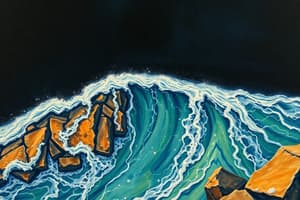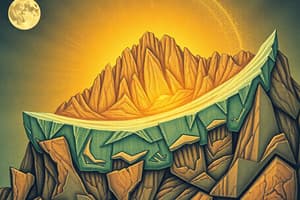Podcast
Questions and Answers
What is the primary composition of the Earth's inner core?
What is the primary composition of the Earth's inner core?
- Solid iron (correct)
- Granite and basalt
- Liquid iron and nickel
- Silicate minerals
Which subfield of geology focuses on the study of fossils?
Which subfield of geology focuses on the study of fossils?
- Paleontology (correct)
- Stratigraphy
- Petrology
- Mineralogy
What type of rock is formed from the accumulation of sediment?
What type of rock is formed from the accumulation of sediment?
- Basalt
- Metamorphic
- Igneous
- Sedimentary (correct)
Which geological process involves the breakdown of rocks into smaller particles?
Which geological process involves the breakdown of rocks into smaller particles?
During which geological era did mammals and birds become prominent?
During which geological era did mammals and birds become prominent?
Which mineral resource is formed from ancient organic materials?
Which mineral resource is formed from ancient organic materials?
What is a significant cause of earthquakes?
What is a significant cause of earthquakes?
Which of the following is NOT considered a geological hazard?
Which of the following is NOT considered a geological hazard?
Flashcards are hidden until you start studying
Study Notes
Basics of Geology
- Definition: Study of the Earth, its materials, processes, and history.
- Subfields:
- Mineralogy: Study of minerals.
- Petrology: Study of rocks.
- Stratigraphy: Study of rock layers and layering.
- Paleontology: Study of fossils and ancient life.
Earth's Structure
- Layers:
- Crust: Thin outer layer; consists of continental and oceanic crust.
- Mantle: Thick layer beneath the crust; composed of silicate minerals.
- Outer Core: Liquid layer composed primarily of iron and nickel.
- Inner Core: Solid center composed mainly of iron.
Rock Types
- Igneous Rocks: Formed from cooled magma or lava.
- Examples: Granite (intrusive), Basalt (extrusive).
- Sedimentary Rocks: Formed from the accumulation of sediment.
- Examples: Sandstone, Limestone.
- Metamorphic Rocks: Formed from existing rocks subjected to heat and pressure.
- Examples: Schist, Gneiss.
Geological Processes
- Weathering: Breakdown of rocks into smaller particles.
- Types: Mechanical (physical) and chemical weathering.
- Erosion: Movement of sediments by wind, water, or ice.
- Plate Tectonics: Movement of the Earth's lithospheric plates.
- Causes earthquakes, volcanic activity, and mountain formation.
Geological Time Scale
- Divided into eons, eras, periods, and epochs.
- Major divisions:
- Precambrian: Formation of Earth and earliest life forms.
- Paleozoic: Development of fish, insects, and plants.
- Mesozoic: Age of reptiles and dinosaurs.
- Cenozoic: Age of mammals and birds.
Natural Resources
- Minerals: Naturally occurring substances with a definite chemical composition.
- Fossil Fuels: Organic materials (coal, oil, natural gas) formed from ancient organisms.
- Metals: Extracted from ores (e.g., iron, copper, gold).
Geological Hazards
- Earthquakes: Sudden shaking of the ground caused by tectonic movements.
- Volcanoes: Eruptions of magma, ash, and gases from beneath the Earth's surface.
- Landslides: Movement of rock and soil down a slope due to gravity.
Environmental Geology
- Focuses on the interactions between humans and geologic processes.
- Topics include:
- Resource management.
- Pollution and waste management.
- Natural disaster preparedness.
Basics of Geology
- Geology encompasses the study of the Earth, its composition, dynamics, and historical development.
- Mineralogy focuses on the analysis of minerals, their properties, and classification.
- Petrology investigates the origins, composition, and structure of rocks.
- Stratigraphy examines the layering of rocks and the temporal sequence of geological events.
- Paleontology delves into the study of fossils, providing insights into ancient life forms.
Earth's Structure
- The crust is the Earth's outermost layer, divided into continental and oceanic varieties.
- The mantle lies beneath the crust, characterized by its thick composition of silicate minerals.
- The outer core is a molten layer primarily made of iron and nickel, playing a crucial role in generating Earth's magnetic field.
- The inner core consists of solid iron, subjected to extreme pressure and temperatures.
Rock Types
- Igneous rocks form from the solidification of magma or lava; examples include granite (intrusive) and basalt (extrusive).
- Sedimentary rocks arise from the accumulation and compaction of sediment, with sandstone and limestone as common examples.
- Metamorphic rocks are created when existing rocks are transformed by heat and pressure, with schist and gneiss as typical examples.
Geological Processes
- Weathering refers to the breaking down of rocks into smaller particles, which occurs through mechanical and chemical processes.
- Erosion describes the transport of sediments via natural agents like wind, water, or ice.
- Plate tectonics involves the movement of Earth's lithospheric plates, resulting in geological phenomena such as earthquakes, volcanic activity, and mountain building.
Geological Time Scale
- The geological time scale is categorized into eons, eras, periods, and epochs for organizing the history of the Earth.
- The Precambrian eon marks Earth's formation and the emergence of the earliest life forms.
- The Paleozoic era saw the evolution of fish, insects, and various plant life.
- The Mesozoic era is known as the Age of Reptiles, marked by the dominance of dinosaurs.
- The Cenozoic era is defined as the Age of Mammals, witnessing the rise of mammals and birds.
Natural Resources
- Minerals are naturally occurring, inorganic solids with a specific chemical formula, crucial for various industries.
- Fossil fuels, such as coal, oil, and natural gas, originate from the remains of ancient organisms and are significant energy sources.
- Metals are derived from ores, with iron, copper, and gold being among the most commonly extracted.
Geological Hazards
- Earthquakes are sudden and intense ground shaking caused by the release of stress along fault lines.
- Volcanoes erupt when magma, along with ash and gases, escapes from the Earth’s interior.
- Landslides occur when gravity leads to the downhill movement of rock and soil materials.
Environmental Geology
- This field studies human interactions with geological processes, emphasizing sustainability and responsible resource use.
- Key topics include effective management of natural resources, pollution control, and strategies for preparedness against natural disasters.
Studying That Suits You
Use AI to generate personalized quizzes and flashcards to suit your learning preferences.




